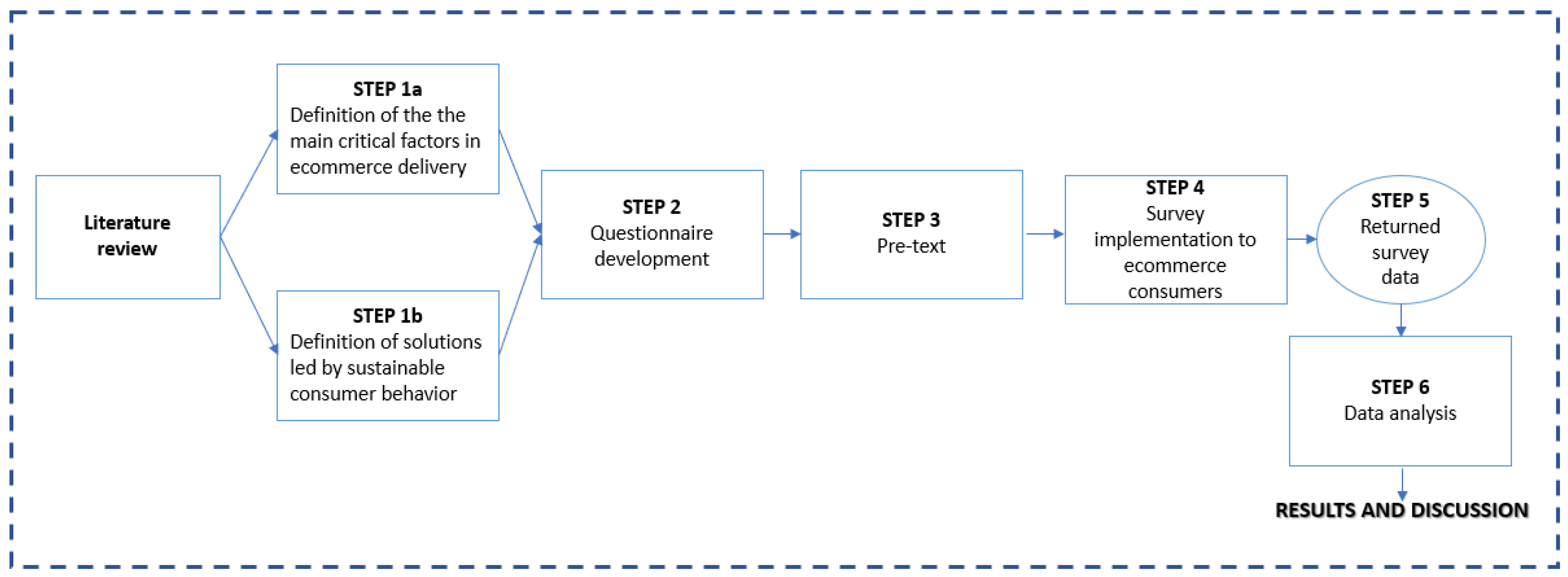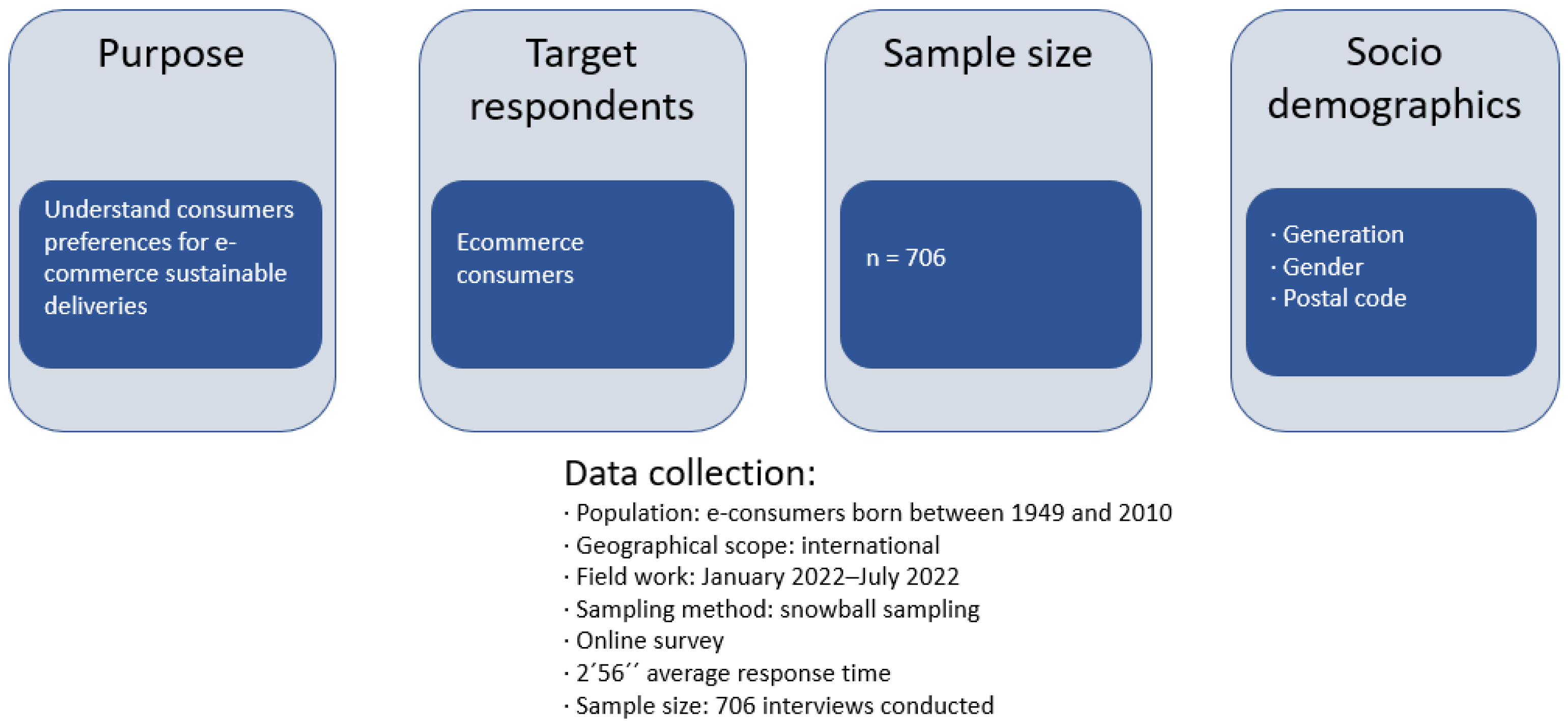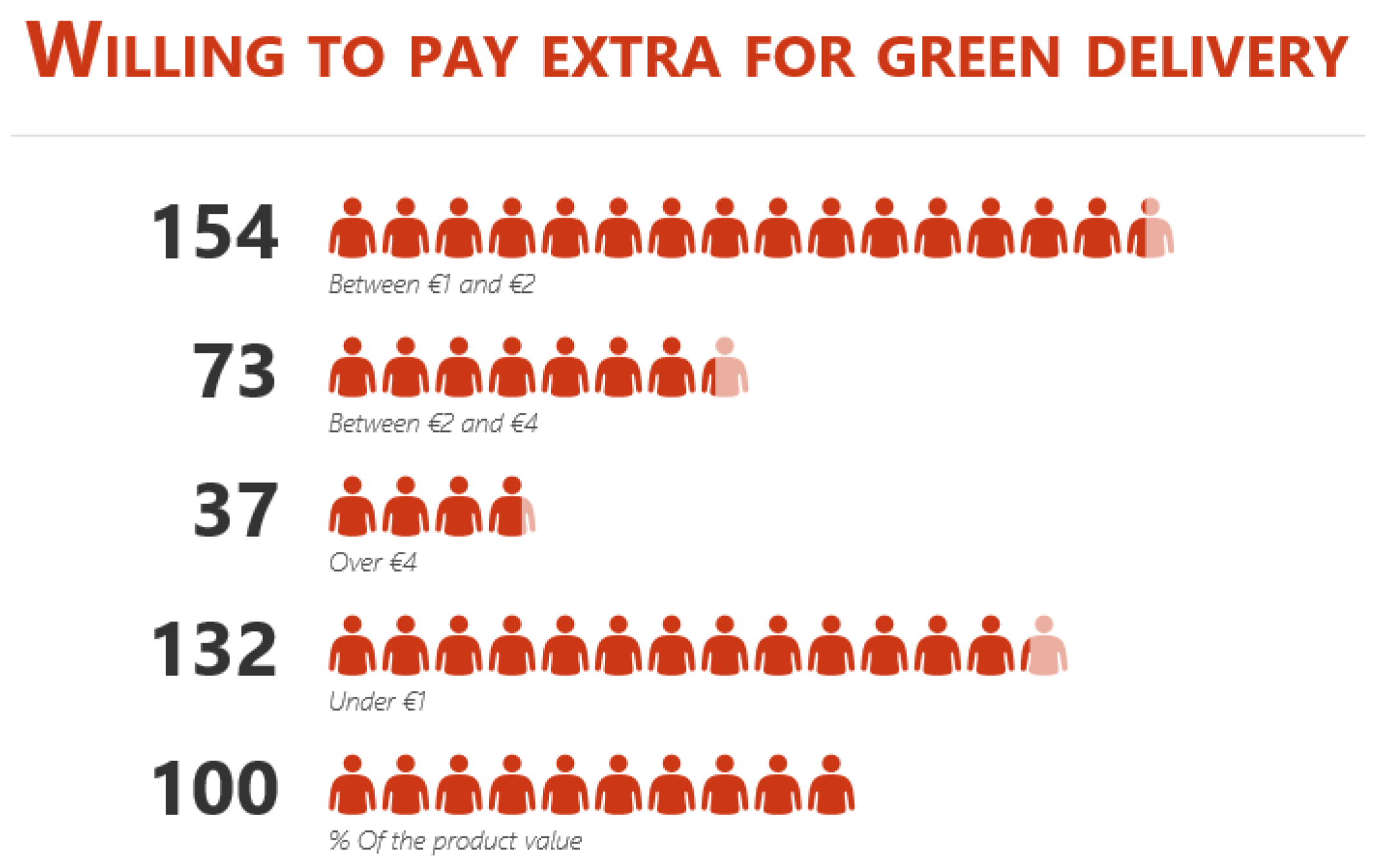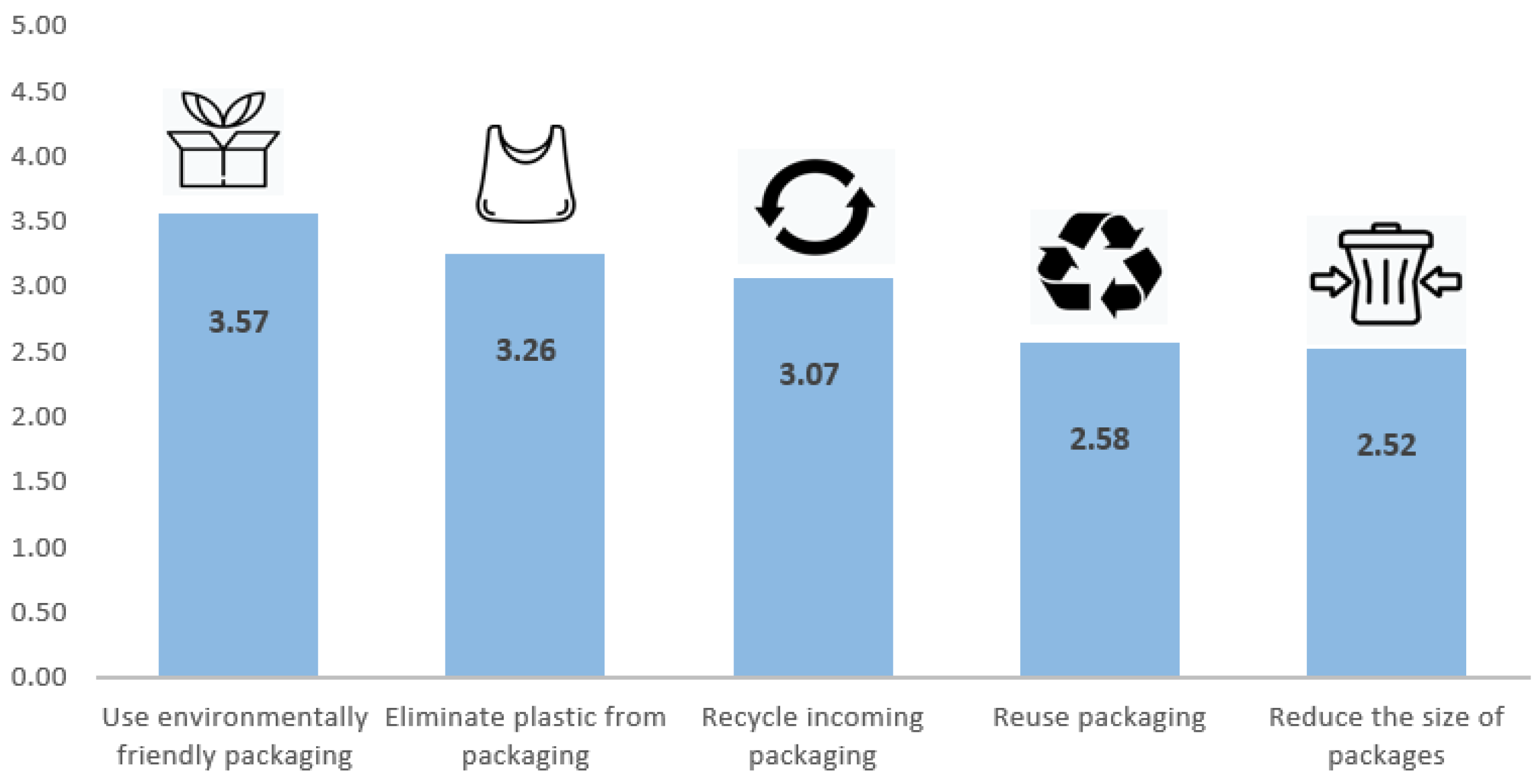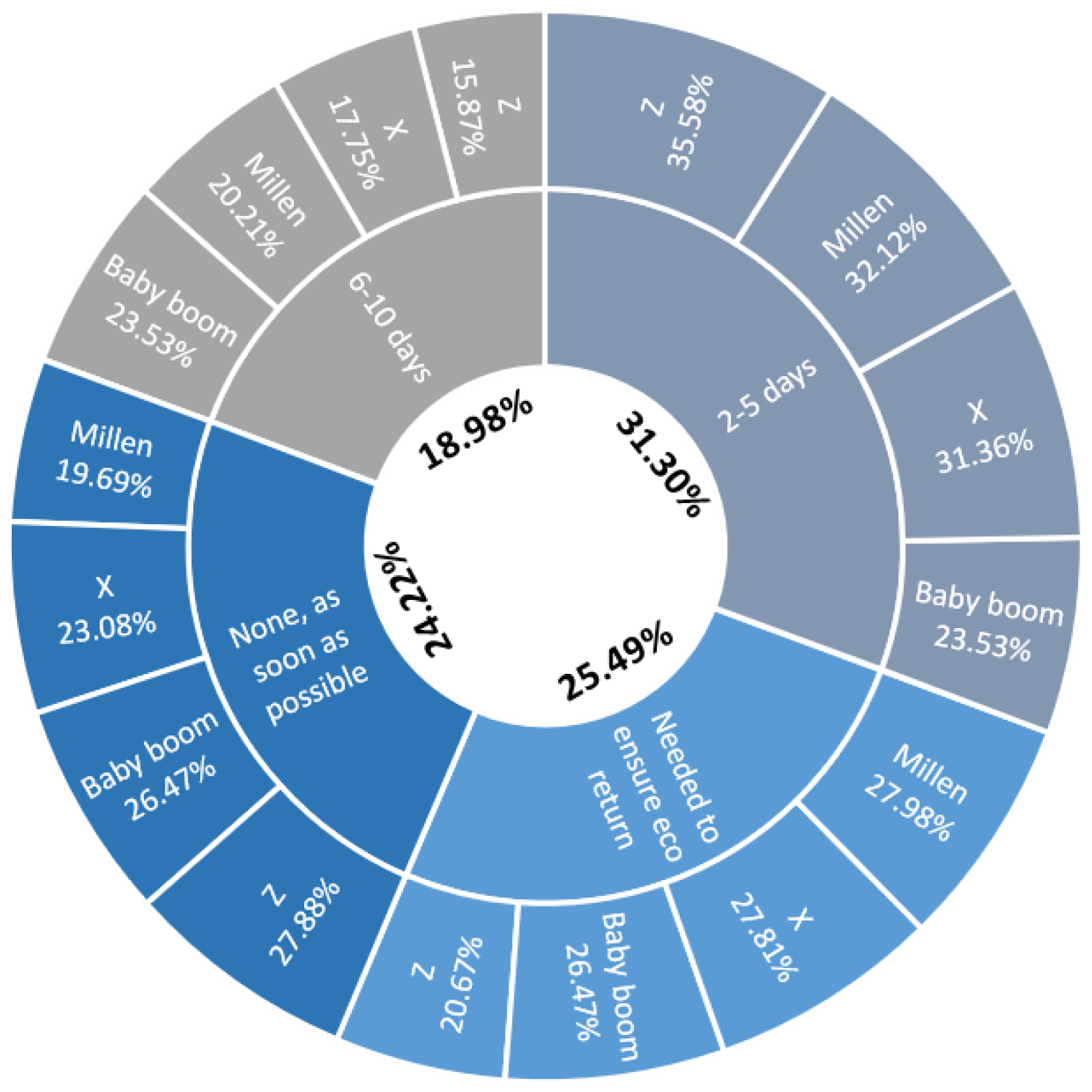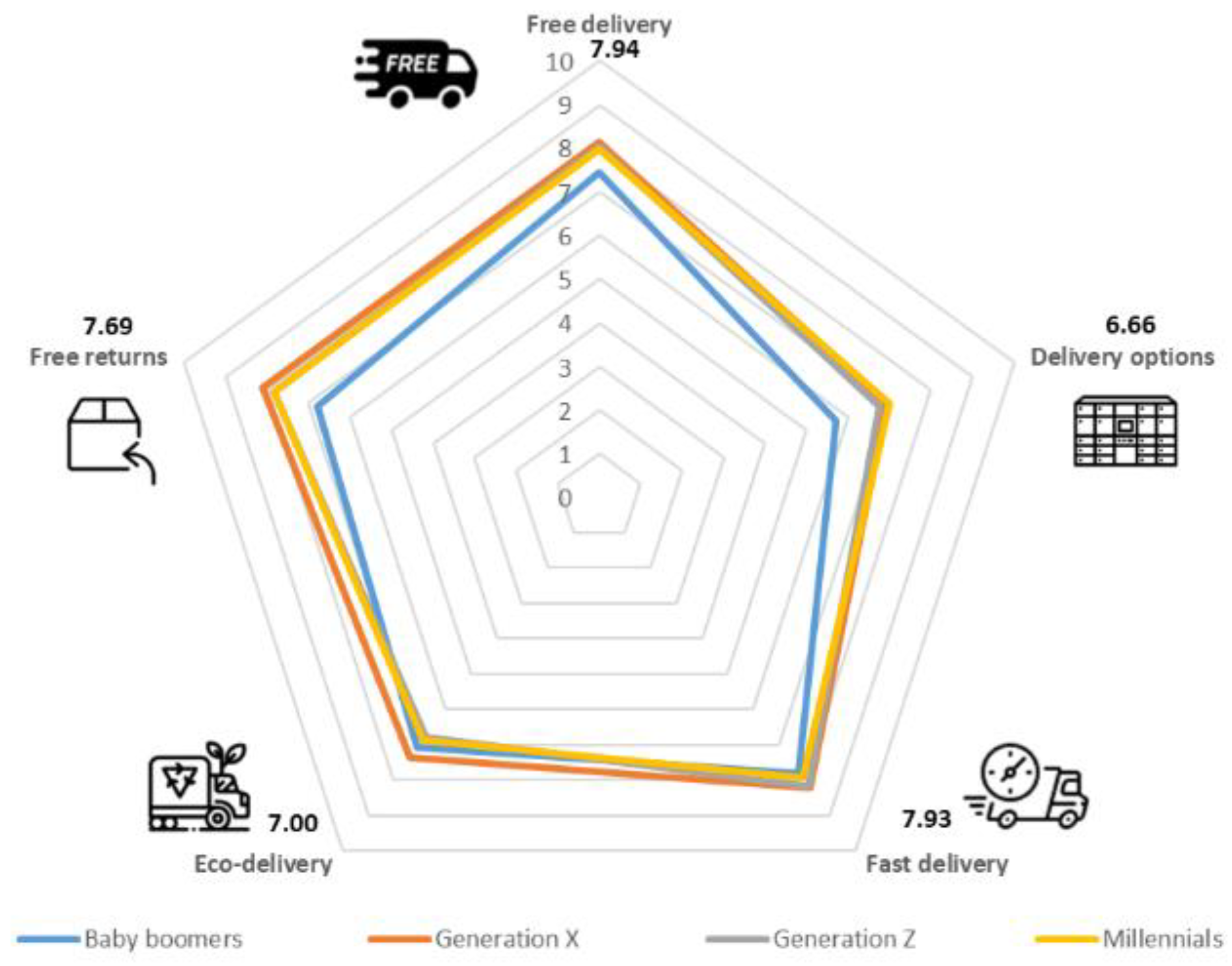1. Introduction
In recent years, especially since the COVID-19 pandemic, e-commerce has become an indispensable part of the global retail market. For months, the internet was the only means by which many businesses could continue to generate revenue, and it was the only way for consumers to access certain goods. Seventy-four per cent of internet users in the EU shopped online in 2021 [
1], with very similar percentages in the rest of the world. According to Statista data, e-commerce in the United States amounted to USD 469.2 billion in 2021, up from USD 431.6 billion in 2020, and in Spain, approximately 24% of total purchases were made over the internet [
2].
Although changes in consumer shopping habits have changed permanently in the wake of the pandemic [
3], from 2022 onwards, this growth in e-commerce has altered as a result of inflation, slower economic growth, and geopolitical conflicts. This has resulted in slower growth in household online spending because of households saving less and buying fewer unneeded items. Despite these temporary adjustments, many experts agree [
4] that the future of retail will be omni-channel-based, with retailers and consumers combining multiple channels to market (O2O model: Offline to Online), sell, buy, and deliver goods. The term ‘phygital’—i.e., physical and digital at the same time—refers to the full integration of the physical and digital worlds in retail.
This phygital experience is evident in e-commerce and in the importance of delivery to customers (physical world), where it has become a critical aspect for consumers over and above the search and online-shopping stages (digital world) [
5,
6]. However, why do companies attach such a high level of importance to delivery issues in e-commerce? During the online-shopping process, consumers tend not to differentiate between the distributor and the carrier, and mistakes made by the carrier are attributed to the retailer. Product reviews on Amazon, for example, often include comments about delivery, both positive and negative. The courier becomes the seller’s representative [
7]. The perceived value of good e-commerce delivery drives customer satisfaction, customer satisfaction drives customer loyalty, and customer loyalty drives profits and growth for these companies (service–profit chain [
8]). Timely product delivery, quantity, and quality are critical to the development of e-commerce as they are closely related to customer satisfaction [
9].
From a sustainability point of view, several authors [
10,
11,
12,
13] point to transport planning and management activities as the most important aspects in addressing the environmental effects of e-commerce. The last leg in transport—i.e., the last-mile delivery—is the most inefficient and energy-intensive part of the logistics chain.
Ignat and Chankov [
14] highlight the need for more research into the perceived sustainability of current delivery methods from a consumer perspective. There is a difference between the perceived and the actual cost of a product [
15], and there is likely to be a difference between perceived and objective sustainability. In other words, what consumers think is sustainable may need to be revised.
Therefore, e-commerce companies need to take consumer perceptions into account when developing their sourcing strategies. This can be achieved by surveying consumers’ sustainability preferences and providing information on the environmental effects of different delivery methods.
Focusing on the place of delivery of goods in e-commerce and the involvement of different actors in the process (customers, sellers, and/or intermediaries), there are three supply-chain models for delivery in the distribution of e-commerce orders [
15]:
The push delivery system: someone other than the seller, usually a logistics service provider (LSP), delivers the goods to the address indicated by the customer. From the starting point—which could be the manufacturer, the retailer, or physical shops—it is the responsibility of the sellers to conduct the entire delivery process. This system is standard, for example, in purchasing clothing through a website, where the seller is responsible for delivery to the customer’s home.
The pull delivery system: in contrast to the push system, customers collect the goods from the points of sale. The customers have full responsibility for the process—from the collection to the delivery of the order at the last desired point. For example, a customer places an order for clothes online, and the same customer picks it up in a shop (BOPIS: buy online and pick up in the store).
The hybrid delivery system: goods are shipped to an intermediate location, where customers pick them up. This system requires the involvement of both the customer and the seller to fulfil the delivery process. For example, consider a clothing order that a customer places online and picks up at a smart locker. In this case, the seller is responsible for the transport part, and the customer is responsible for the other part.
This research covers the three delivery systems shown in
Figure 1: push delivery, pull delivery, and hybrid delivery. It also examines how these systems relate to the preferences expressed by e-commerce customers for different sustainable delivery options.
4. Methodology
To prove the research hypotheses, this study is divided into six stages, following the methodology outlined in
Figure 2.
Based on a literature review conducted by the author, both the critical success factors of e-commerce delivery and the leading potential sustainable solutions from the perspective of online consumers were defined (step 1). Also based on this review, a questionnaire was developed and pre-tested with a group of 10 online consumers (steps 2–3). This pre-text questionnaire was used to refine the questions based on the feedback from the respondents. Some aspects of the questionnaire that made it challenging to answer were removed, and other questions were reworded to make them appear more straightforward. The final questionnaire was launched through a snowball-sampling process (non-probabilistic, with inference only applied to the studied group), which produced 706 responses (steps 4–5). Finally, an analysis of the survey data was carried out to determine the results (step 6) and to answer the research questions.
To achieve the set objective, the survey was carried out between July and December 2022. The research took the form of a descriptive survey, with all questions (except one) closed-ended, using the CAWI (computer-assisted web interviewing) technique. Several online consumers from different generations and regions were invited to share the survey and invite their friends, who met the age and e-commerce consumer conditions to participate. The study was partial, participation was voluntary and anonymous, and the respondents could refrain from completing the form at any time. Of the 745 questionnaires collected, 706 reliably completed questionnaires were accepted. The only change open to the respondents was the postcode, and surveys in which this field was not filled in were accepted (see the survey sheet in
Figure 3).
The survey was conducted with Microsoft Forms (English and Spanish) and consisted of three sections. The first part contained the respondents’ primary data: gender, generation by age at birth (baby boomers, generation X, millennials, or generation Z), and the postcode where the respondent lived. In the second part, the respondents were asked about his/her willingness to pay for additional shipping costs if the company guaranteed an environmentally friendly delivery (yes or no). If the answer was yes, the respondent was asked to define the additional amount he/she would be willing to pay. Furthermore, in this section, the respondents are asked about the packaging (several sustainable alternatives to reduce the environmental impact are shown) and returns of online orders, and they were asked to indicate how long they would be willing to delay the collection of the return of an e-commerce order if the company selling the product guaranteed an environmentally friendly return. Finally, in the last section, the respondents rated five critical aspects of e-commerce delivery, from 0 (minimum) to 10 (maximum). The created form was subjected to a reliability analysis, for which Cronbach’s alpha test was calculated. The test result was 0.72275, which was satisfactory [
80]. A statistical analysis was carried out using descriptive and inferential analyses. Descriptive analysis was used to describe the main characteristics of the sample, using the mean and standard deviation, and Pearson’s correlation analysis was calculated among the respondents’ evaluations of the critical factors in e-commerce delivery. Inferential analysis was performed using a multivariate logistic regression model for the dichotomous outcome, ‘willingness to pay for green e-commerce delivery’—structured as 1 = ‘yes, willing to pay’ and 0 = ‘not willing to pay’—as a function of gender, the generation to which the participants belonged, and the ratings given by these consumers to the critical factors assessed in e-commerce delivery. The results of the regression analysis were expressed as odds ratio (OR) and standard error (SE) with the corresponding 95% confidence intervals, and the level of statistical significance set at the
p-value was ≤0.05. Statistical analyses of the collected material were performed with the Microsoft Excel 2021 software (Real statistics 8.0) add-in, ‘Real statistics’, which extends the built-in statistical capabilities of Excel and allows a wide range of statistical analyses to be performed more efficiently.
5. Results
The study targeted four generations, from 16 to 73 years old, but with the condition that they were online shoppers. Responses were received from 390 men, 312 women, and 4 of other genders. By country, the most significant number of responses was received from Spain—90.93%. The remaining responses (9.07%) were split between European and American countries (see
Table 2).
The distribution of responses by generation was relatively balanced. Generation Z stood out slightly, with 29.5% of the total responses, followed by millennials, with 27.3%. Generation X accounted for 23.9% of the responses, and in last place was the oldest generation, the baby boomers, with 19.3%.
With regard to green delivery and delivery costs, in response to the survey’s main question—‘Would you be willing to pay extra for the delivery costs of a parcel if the company selling the product guarantees an environmentally friendly delivery (e.g., climate or CO
2 neutral)?’—70.25% of the respondents answered yes. There were notable gender differences. While 35.64% of men said they would not be willing to pay more for guaranteed green delivery, this percentage dropped by more than 13 points for the women, with only 22.12% saying they would not be willing to pay more. For those of other genders, the split was 50% in favor and 50% against. Surprisingly, in terms of generation, the respondents from the baby-boomer generation (1949–1968) are the most willing to pay for green e-commerce-parcel delivery (see
Figure 4). On the other hand later generations had very similar percentages in favor of guaranteed green delivery (30.18–32.12%) but with a considerable gap from the baby boomers.
By region, there was no significant difference between those favoring green delivery in Spain (69.78%) and those in European countries (70.37%). Among the respondents residing in the different countries of the Americas (see
Table 2), a higher percentage of people favored green delivery (75.76%).
For those who answered yes to the previous question (n = 496), a new question was added—‘What additional amount (EUR) per package would you be willing to pay for a guaranteed green delivery?’. The most frequently accepted options (chosen by more than half of the respondents) were (i) paying between EUR 1 and EUR 2 (31.05%) and (ii) paying less than EUR 1 (26.61%). The least frequently selected option was paying more than EUR 4 for e-commerce delivery, with only 37 responses (7.46%; see
Figure 5). It is important to note that the option to ‘pay according to the value of the product’ was supported by 20.16% of the respondents. When analyzing these payment alternatives by gender and region of residence, there were no significant differences among the responses received.
Regarding the packaging of e-commerce products, the respondents were asked to rank, from 5 points (highest) to 1 point (lowest), the alternatives they considered most appropriate to reduce the environmental impact they produced. The alternative with the highest average score was (i) using packaging made from environmentally friendly materials, followed by (ii) eliminating plastic from current packaging received in e-commerce deliveries (see
Figure 6). Notably, eliminating plastic was the most frequent first choice (215), but it was also the last option to be considered by many of the respondents (129).
The three Rs of recycling (reduce, reuse, and recycle) were ranked in reverse order. Among these three options, the recycling of the packaging received was the most commonly preferred. The re-use of and reduction in packaging had very similar scores, although the option of reusing was the most frequently chosen as the last option (215). The main statistics related to the packaging preferences of the sample surveyed are shown in
Table 3.
The question returns was as follows: ‘How long would you be willing to delay collecting an e-commerce order return if the company selling the product guarantees an environmentally friendly return?’. As shown in
Figure 7, there was no clear preferred option. The option to return the e-commerce package between 2 and 5 days was the preferred option for 31.30% of the total sample. The second most frequently chosen option was ‘as long as necessary to guarantee the ecological return’ (25.49%). This was followed by a significant percentage (24.22%) who stated that they did not want the return to be environmentally friendly, preferring that it be collected as soon as possible. Finally, 18.98% chose to return their order online after between 6 and 10 days.
Among the generations (see
Figure 4), the millennials were the most willing to wait if the return was sustainable. In total, 80.31% of the millennials did not mind waiting if an ecological delivery was guaranteed, with the following waiting times noted: between 2 and 5 days (32.12%), between 6 and 10 days (20.21%), or as long as necessary (27.98%). The rest of the generations had similar percentages, except for generation Z, who were the least willing to wait when the delivery time was between 6 and 10 days (15.87%) and who, to a greater extent, expressed their refusal to wait for an ecological return in e-commerce (27.88%). Between 2 and 5 days was the most frequently preferred option for both men and women. It is noteworthy that the women showed a significantly higher preference for an eco-friendly return than the other sexes, irrespective of the waiting time (see
Table 4).
To assess the success factors related to e-commerce delivery, the survey asked the consumers to rate from 0 (lowest score) to 10 (highest score) the following aspects: (i) free delivery, (ii) delivery alternatives (smart lockers, pick-up centers, etc.), (iii) speed of delivery, (iv) green delivery (CO2 neutral), and (v) free returns.
First, a correlation matrix was constructed to measure the linear association of these variables (see
Table 5), which showed the correlation coefficients among the variables related to e-commerce delivery for the survey conducted. The correlation coefficient measures the relationship between two variables and ranges from −1 to +1. These values should be interpreted in two ways. The modulus of the number informs the strength of the relationship between the variables, while the ‘+’ sign determines that the direction is directly proportional and the ‘−’ sign is inversely proportional [
80].
The correlations between the variables were positive but weak or very weak for most of the variables assessed. Only the variables ‘free returns’ and ‘free delivery’ were considered moderately correlated. At a lower level, the relationships between ‘fast delivery’ and ‘free delivery’ and ‘fast delivery’ and ‘free returns’ appeared with a correlation higher than 0.5.
As shown in
Table 6, the most highly rated factor was fast delivery, with an average rating of 8.05 from the surveyed e-commerce customers. Next, the highest-rated aspects were related to cost: free delivery (7.94) and then free returns (7.69). Green e-commerce delivery reached fourth place, with a score of 7.00; in last place, e-commerce customers rated the delivery alternatives available to them the lowest (6.66). As these ratings were obtained on a scale of 0 to 10 and all the options given were positive for the customers, the highest score was the most frequent value (mode) for all the aspects evaluated. Of the 706 respondents, 49 simultaneously scored the highest on all five factors.
The groups provided consistent ratings by generation (see
Figure 8). The baby boomers rated all the e-commerce factors the lowest, except for eco-delivery (7.07), which generation Z rated the lowest (6.78). On the other hand, generation X rated four of the five factors the highest. Only delivery options were rated slightly higher by the millennials (6.97 vs. 6.94).
Concerning gender (see
Table 7), there were no significant differences between the men and the women, and the ratings were very similar in all the aspects assessed. Regarding the ‘other’ category, very few persons were surveyed, which means that their data were not significant for comparison. Regarding the region of origin, the Spaniards rated all the critical factors of e-commerce delivery proposed lower than the rest of their European contemporaries and the respondents from American countries.
To determine the best predictors of the willingness to pay for eco-friendly e-commerce delivery, a logistic regression was performed, as it is a statistical method that allows the modeling of the probability of a binary qualitative variable (two possible values) as a function of one or more independent variables [
81,
82]. In the logistic regression model in our research, the values of the probabilities to be predicted corresponded with the dependent variable: ‘willingness to pay extra for an ecological e-commerce delivery.’ This had two possible values (1 = willingness to pay and 0 = unwillingness to pay), and the following independent variables or features were presented: gender (qualitative binary variable), generation (qualitative ordinal variable), and the quantitative variables related to the critical success factors in e-commerce deliveries analyzed in
Table 5.
The multiple logistic regression model (
Table 8) showed that sex (
p = 0.0016), free delivery (
p = 0.0001), delivery options (
p = 0.0256), and eco-delivery (
p ≤ 0.05) contribute to the model and are related to the willingness to pay the additional cost for eco-delivery in e-commerce (statistically significant
p-values are highlighted in bold). In contrast, generation, fast delivery, and free returns (
p > 0.05) do not contribute to the model and should not be used as predictor variables.
The logistic regression model was significant overall, with a
p-value < 0.05 and a χ2 value = 136.98 (7 df), with an alpha = 0.05. The model’s accuracy was 74.08%, indicating that it correctly classified 74.08% of the observations. Below is the receiver operator characteristic (ROC) curve, which shows the diagnostic capability of binary classifiers [
83]. The graph shows the true positive rate (TPR) versus the false positive rate (FPR). The TPR is the proportion of observations that were correctly predicted as positive out of all the positive observations (TP/(TP + FN)). The proximity of the curve to the upper left corner indicates a better model performance (see
Figure 9).
6. Discussion
Our research confirmed the two hypotheses presented in this study: H1 and H2. Regarding H1, most of the respondents (70.25%) expressed their willingness to pay additional costs for guaranteed green e-commerce delivery. The results align with those of previous studies [
6,
74,
75,
76,
84]. However, it is important to note that in the face of a generic question, there is a greater risk of response bias (respondents may feel pressured to give socially acceptable answers [
85]). To mitigate this potential for generality in the responses, the respondents were asked to specify the amount of money they would be willing to pay, as those who favored lower prices may have been more price-sensitive and may have changed their opinions. The majority result was that the consumers surveyed would pay between EUR 1 and EUR 2 per shipment (31.05%), and less than EUR 1 (26.61%) for an organic online order. The remaining 42.34% would be willing to pay more than EUR 2 or a percentage of the value of a product. With online returns, a large majority (three out of four of the respondents) would be willing to delay the return of an e-commerce package if an environmentally friendly return was guaranteed, albeit with different deadlines. Notably, one in four of the respondents said they were unwilling to wait for an environmentally friendly return. These results can help guide e-retailers and other stakeholders to explore new sustainable practices related to delivering e-commerce.
Regarding H2, there were significant differences between the generations and genders in terms of their willingness to pay additional costs for green deliveries. Contrary to expectations, the older generation (baby boomers) showed a higher willingness to pay for green deliveries than the more modern generations (generation X, millennials, and generation Z). These results differ from those in previous research, in which more modern generations showed more environmentally friendly behavior, in that they were more eco-friendly and more technology- and sustainability-oriented [
51,
79,
86]. This could have been because, although later generations are more socially conscious, or greener, the need to pay to be green was higher in this research. In this context, baby boomers may have greater purchasing power, allowing them to afford this extra cost, but no data are available to corroborate this hypothesis. Regarding gender, women (77.88%) are more willing to pay additional costs for eco-deliveries (more than 13 percentage points than men). In this case, the results align with the those in the literature review [
54,
77].
The study rejected H3 as, among the five best sustainable practices for recycling proposed, the respondents preferred the use of environmentally friendly materials in packaging. This solution is closely related to the second-highest-rated alternative, ‘eliminate plastic from the packaging we receive in e-commerce’, as both alternatives are designed to avoid generating waste that cannot be reused. When an online order arrives at consumers’ homes, consumers throw the packaging straight into the bin, which highlights the problem of packaging waste in e-commerce: most e-commerce packaging is not designed with sustainability in mind [
49,
50]. This is an example of a linear economy, in which items move through a unidirectional production, use, and disposal process. The alternative is moving towards a circular packaging economy, in which resources are continually reused or renewed to provide ongoing value. In our research, the three Rs of recycling (reduce, reuse, and recycle) were rated next, although the alternative of recycling packaging was rated higher than reusing and reducing.
Free delivery was the most highly rated critical aspect of e-commerce delivery in our research. This fact rejects H4, but it should be noted that the ratings were very similar between the two aspects (8.05 vs. 7.94). The difference between this result and those of previous consumer studies is that the consumers were given a choice between the alternatives (only one choice), with cost being the preferred option in these cases [
48,
49]. The cost of returns ranked below the cost of deliveries, in third place. Green deliveries were rated lower than the cost aspects, indicating that the surveyed customers, on the one hand, were willing to pay for green delivery but, on the other hand, that they valued free delivery and returns more highly. This assessment may indicate that consumers prefer and value green deliveries but still want deliveries to be free of charge, i.e., consumers are positively inclined towards sustainable consumption but do not change their behavior when they encounter economic barriers [
54]. Delivery alternatives (parcel lockers, delivery points, etc.) were rated the lowest of all the aspects of e-commerce delivery, highlighting that the convenience and security of home delivery outweigh any possible alternatives [
27].
Finally, H5 was rejected as the logistic regression indicated that the best predictors of the willingness to pay for green delivery in e-commerce were the following variables (in this order): green delivery, free delivery, gender, and delivery options. According to the results, socio-demographic factors (sex and generation) are not the best predictors in the regression model. Generation does not serve as a predictor of willingness to pay, free return, or fast delivery. There was no strong correlation among the explanatory variables that made up the logistic regression model. As expected, there was only a positive (albeit moderate) correlation between the ‘free returns’ and ‘free delivery’ variables. Again, it is important to highlight the differences between environmental awareness and willingness to pay for environmental issues. Environmental awareness may be a distinctive trait among the younger generation, but it is separate from price-to-pay issues [
55].
7. Conclusions, Limitations, and Future Research
According to the data collected, this research shows that consumers are initially aware of or willing to adopt sustainable measures in e-commerce delivery. There is a willingness to pay additional costs if green delivery is guaranteed and sustainable delivery aspects are valued. However, when analyzing the most important factors in e-commerce parcel delivery, speed and free pick-up are aspects that e-consumers place ahead of green delivery. This study’s findings stress the need to balance the drive for speed and cost-effectiveness in e-commerce delivery with the urgency to adopt sustainable practices. This underscores the necessity for e-commerce platforms and logistics partners to take the lead in crafting and implementing innovative green delivery solutions while educating and consumers and incentivizing them to choose sustainable delivery options. This dichotomy highlights that these consumers are inclined towards sustainable delivery until economic barriers are encountered. As companies try to differentiate themselves further in e-commerce through their sustainability policies, it would be interesting to explore, in future research, the best alternative to passing on the associated additional charges so that customers can be assured of green delivery and still believe that they are receiving free and fast deliveries. One alternative could be to increase product prices or make customers pay an annual subscription while offering deliveries that are environmentally friendly.
This study also shows significant differences in terms of the willingness to pay between generations and genders. In theory, more modern generations are more aware of sustainability, but regarding payment, they are more reluctant than older generations. One possible explanation may be that younger generations have, in general, fewer financial resources than older generations. The former may consider it an obligation for companies to be sustainable and may need to understand that they must pay for products or services that should be compulsory in society. Regarding gender, women are more environmentally conscious, which can help retailers to personalize deliveries according to product type and target customer.
Regarding packaging, although many studies focus on the three Rs in e-commerce, the respondents favored using environmentally friendly packaging in and eliminating plastic from e-commerce deliveries. The shipping of products is part of the online shopping experience, and the packaging used plays a key role in adding value for customers. Several sustainable alternatives to traditional plastic-packaging systems exist, such as biodegradable, compostable products or products made from 100% natural materials. The problems arise when plastic is used for disposability purposes, which causes large quantities of plastic to accumulate. However, if plastic packaging is reused and recycled, it can be a valuable and durable material.
Based on the research results, different stakeholders can take actions that are beneficial to them and, at the same time, ensure the sustainability of e-commerce deliveries. Information regarding the willingness of consumers to become more sustainable must be visible and known to all stakeholders because when this information is made available to different actors, they can make more responsible and environmentally friendly decisions.
Finally, according to the survey data, gender may be a good predictor of willingness to pay, but generation is not. The research shows, unsurprisingly, how variables related to environmental awareness (eco-delivery and delivery options) can also be used as predictors of willingness to pay.
Within the theoretical implications of the study, the results of our research provide valuable insights for future researchers seeking to understand how different alternatives can be implemented to improve the sustainability of e-commerce delivery from the perspective of customers. Our research specifically focuses on determining the willingness to pay for green deliveries and assessing various green alternatives while also analyzing the differences between the generations. Therefore, our methodology may also pave the way for further research to gather detailed information on how to materialize and implement measures that reflect the greener attitudes of e-commerce customers.
Among the limitations of the results of our study, we acknowledge that this is a rapidly evolving field and that the references used in this research may need to be updated in the future. In order to provide a comprehensive understanding of the topic, future revisions of this paper will aim to incorporate the latest research in the field of e-commerce and green practices. Within this research, although the respondents’ postcodes are known, information regarding the income of the participants would be relevant. It would be interesting to have this information available and to determine whether there is a relationship between income level and willingness to pay for green e-commerce deliveries. On the other hand, the sampling was non-probabilistic, using the snowball-sample selection method (in which the subjects choose the next one to be surveyed because they meet the requested criteria), which implies that the results cannot be generalized. However, probabilistic sampling could provide more reliable information, and the distribution of respondents by country of origin would be more evenly distributed and less biased.
This research highlights the interest of consumers in the different options that can be presented in the packaging of e-commerce orders. In this sense, future research related to sustainable e-commerce could address packaging and its different alternatives within online orders in greater depth, as it is one of the polluting activities studied the least in the literature. Similarly, it would be desirable to carry out a study with a more balanced sample, according to country of origin, and to be able to compare the differences between them.

